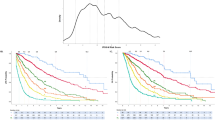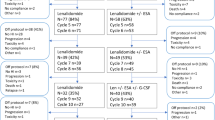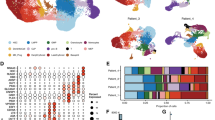Abstract
Using ProteinChip array technology, which is based on the surface-enhanced laser desorption/ionization time-of-flight mass spectrometry, we performed proteomic analyses on sera from myelodysplastic syndromes (MDSs) patients with an interstitial deletion of the long arm of chromosome 5 (del(5q)) and those from control individuals. One analysis with 80 samples from 29 patients and 51 control subjects resulted in the detection of 61 peak differences. Another analysis with 36 paired-samples from 18 patients collected before and after the treatment with lenalidomide (Revlimid) identified 19 differential peak features. We also observed differential profiles between the pre-treatment samples from the responders and those from the non-responders reflected by eight peak differences. On the basis of these data we developed two classification models that could distinguish between the diseased and the control subjects or between the responders and the non-responders. Efforts were made to purify and identify a range of differential peak proteins. We conclude that inter-α trypsin inhibitor, heavy chain H4 (fragments), serum transferrin, transthyretin (variants), haemoglobin and a protein peak at m/z 2791 could be potential disease-associated markers for del(5q) MDS. Platelet factor 4 (PF-4) and a peak at m/z 8559 may serve as therapy-associated markers and be potentially useful for monitoring and predicting the response to therapy.
This is a preview of subscription content, access via your institution
Access options
Subscribe to this journal
Receive 12 print issues and online access
$259.00 per year
only $21.58 per issue
Buy this article
- Purchase on SpringerLink
- Instant access to full article PDF
Prices may be subject to local taxes which are calculated during checkout





Similar content being viewed by others
References
Heaney ML, Golde DW . Myelodysplasia. N Engl J Med 1999; 340: 1649–1660.
Hofmann WK, Ottmann OG, Ganser F, Hoelzer D . Myelodysplastic syndromes: clinical features. Semin Hematol 1996; 33: 177–185.
Schiffer CA . Clinical issue in the management of patients with myelodysplasia. Hematology 2006; 1: 205–210.
Hofmann WK, Koeffler HP . Myelodysplastic syndrome. Annu Rev Med 2005; 56: 1–16.
Bennett JM, Catovsky D, Daniel MT, Flandrin G, Galton DA, Gralnick HR et al. Proposals for the classification of the myelodysplastic syndromes. Br J Haematol 1982; 51: 189–199.
Cazzola M, Malcovati L . Myelodysplastic syndromes-coping with ineffective hematopoiesis. N Engl J Med 2005; 352: 536–538.
Steensma DP, Tefferi A . The myelodysplastic syndrome(s): a perspective and review highlighting current controversies. Leuk Res 2003; 27: 95–120.
Bennett JM . World Health Organization classification of the acute leukemias and myelodysplastic syndrome. Int J Hematol 2000; 72: 131–133.
Petricoin EF, Liotta LA . SELDI-TOF-based serum proteomic pattern diagnostics for early detection of cancer. Curr Opin Biotechnol 2004; 15: 24–30.
Issaq HJ, Veenstra TD, Conrads TP, Felschow D . The SELDI-TOF MS approach to proteomics: protein profiling and biomarker identification. Biochem Biophys Res Commun 2002; 292: 587–592.
Xiao Z, Luke BT, Izmirlian G, Umar A, Lynch PM, Phillips RK et al. Serum proteomic profiles suggest celecoxib-modulated targets and response predictors. Cancer Res 2004; 64: 2904–2909.
Miyamae T, Malehorn DE, Lemster B, Mori M, Imagawa T, Yokota S et al. Serum protein profile in systemic-onset juvenile idiopathic arthritis differentiates response versus nonresponse to therapy. Arthritis Res Ther 2005; 7: R746–R755.
List A, Dewald G, Bennett J, Giagounidis A, Raza A, Feldman E et al. Myelodysplastic Syndrome-003 Study Investigators. Lenalidomide in the myelodysplastic syndrome with chromosome 5q deletion. N Engl J Med 2006; 355: 1456–1465.
Cheson BD, Bennett JM, Kantarjian H, Pinto A, Schiffer CA, Nimer SD et al. World Health Organization (WHO) international working group. Report of an international working group to standardize response criteria for myelodysplastic syndromes. Blood 2000; 96: 3671–3674.
Agranoff D, Fernandez-Reyes D, Papadopoulos MC, Rojas SA, Herbster M, Loosemore A et al. Identification of diagnostic markers for tuberculosis by proteomic fingerprinting of serum. Lancet 2006; 368: 1012–1021.
McMorran BJ, Patat SA, Carlin JB, Grimwood K, Jones A, Armstrong DS et al. Novel neutrophil-derived proteins in bronchoalveolar lavage fluid indicate an exaggerated inflammatory response in pediatric cystic fibrosis patients. Clin Chem 2007; 53: 1782–1791.
Noble JL, Dua RS, Coulton GR, Isacke CM, Gui GP . A comparative proteinomic analysis of nipple aspiration fluid from healthy women and women with breast cancer. Eur J Cancer 2007; 43: 2315–2320.
Villar-Garea A, Griese M, Imhof AJ . Biomarker discovery from body fluids using mass spectrometry. Chromatogr B Analyt Technol Biomed Life Sci 2007; 849: 105–114.
Diamandis EP . Mass spectrometry as a diagnostic and a cancer biomarker discovery tool: opportunities and potential limitations. Mol Cell Proteomics 2004; 3: 367–378.
Poon TC . Opportunities and limitations of SELDI-TOF-MS in biomedical research: practical advices. Expert Rev Proteomics 2007; 4: 51–65.
Pusztai L, Gregory BW, Baggerly KA, Peng B, Koomen J, Kuerer HM et al. Pharmacoproteomic analysis of prechemotherapy and postchemotherapy plasma samples from patients receiving neoadjuvant or adjuvant chemotherapy for breast carcinoma. Cancer 2004; 100: 1814–1822.
Zhang Z, Bast Jr RC, Yu Y, Li J, Sokoll LJ, Rai AJ et al. Three biomarkers identified from serum proteomic analysis for the detection of early stage ovarian cancer. Cancer Res 2004; 64: 5882–5890.
Fung ET, Yip TT, Lomas L, Wang Z, Yip C, Meng XY et al. Classification of cancer types by measuring variants of host response proteins using SELDI serum assays. Int J Cancer 2005; 115: 783–789.
Villanueva J, Shaffer DR, Philip J, Chaparro CA, Erdjument-Bromage H, Olshen AB et al. Differential exoprotease activities confer tumor-specific serum peptidome patterns. J Clin Invest 2006; 116: 271–284.
Piñeiro M, Alava MA, González-Ramón N, Osada J, Lasierra P, Larrad L et al. ITIH4 serum concentration increases during acute-phase processes in human patients and is up-regulated by interleukin-6 in hepatocarcinoma HepG2 cells. Biochem Biophys Res Commun 1999; 263: 224–229.
Piñeiro M, Andrés M, Iturralde M, Carmona S, Hirvonen J, Pyörälä S et al. ITIH4 (inter-alpha-trypsin inhibitor heavy chain 4) is a new acute-phase protein isolated from cattle during experimental infection. Infect Immun 2004; 72: 3777–3782.
González-Ramón N, Hoebe K, Alava MA, Van Leengoed L, Piñeiro M, Carmona S et al. Pig MAP/ITIH4 and haptoglobin are interleukin-6-dependent acute-phase plasmaproteins in porcine primary cultured hepatocytes. Eur J Biochem 2000; 267: 1878–1885.
Mundle SD, Reza S, Ali A, Mativi Y, Shetty V, Venugopal P et al. Correlation of tumor necrosis factor alpha (TNF alpha) with high Caspase 3-like activity in myelodysplastic syndromes. Cancer Lett 1999; 140: 201–207.
Rai AJ, Zhang Z, Rosenzweig J, Shih IeM, Pham T, Fung ET et al. Proteomic approaches to tumor marker discovery. Arch. Pathol Lab Med 2002; 126: 1518–1526.
Ward DG, Suggett N, Cheng Y, Wei W, Johnson H, Billingham LJ et al. Identification of serum biomarkers for colon cancer by proteomic analysis. Br J Cancer 2006; 94: 1898–1905.
Escher N, Kaatz M, Melle C, Hipler C, Ziemer M, Driesch D et al. Posttranslational modifications of transthyretin are serum markers in patients with mycosis fungoides. Neoplasia 2007; 9: 254–259.
Liu L, Liu J, Dai S, Wang X, Wu S, Wang J et al. Reduced transthyretin expression in sera of lung cancer. Cancer Sci 2007; 98: 1617–1624.
Miguet L, Bogumil R, Decloquement P, Herbrecht R, Potier N, Mauvieux L et al. Discovery and identification of potential biomarkers in a prospective study of chronic lymphoid malignancies using SELDI-TOF-MS. J Proteome Res 2006; 5: 2258–2269.
Koomen JM, Shih LN, Coombes KR, Li D, Xiao LC, Fidler IJ et al. Plasma protein profiling for diagnosis of pancreatic cancer reveals the presence of host response proteins. Clin Cancer Res 2005; 11: 1110–1118.
Kozak KR, Amneus MW, Pusey SM, Su F, Luong MN, Luong SA et al. Identification of biomarkers for ovarian cancer using strong anion-exchange ProteinChips: potential use in diagnosis and prognosis. Proc Natl Acad Sci USA 2003; 100: 12343–12348.
Woong-Shick A, Sung-Pil P, Su-Mi B, Joon-Mo L, Sung-Eun N, Gye-Hyun N et al. Identification of hemoglobin-alpha and -beta subunits as potential serum biomarkers for the diagnosis and prognosis of ovarian cancer. Cancer Sci 2005; 96: 197–201.
Aivado M, Spentzos D, Germing U, Alterovitz G, Meng XY, Grall F et al. Serum proteome profiling detects myelodysplastic syndromes and identifies CXC chemokine ligands 4 and 7 as markers for advanced disease. Proc Natl Acad Sci USA 2007; 104: 1307–1312.
Cho WC, Yip TT, Ngan RK, Yip TT, Podust VN, Yip C et al. ProteinChip array profiling for identification of disease- and chemotherapy-associated biomarkers of nasopharyngeal carcinoma. Clin Chem 2007; 53: 241–250.
Vermeulen R, Lan Q, Zhang L, Gunn L, McCarthy D, Woodbury RL et al. Decreased levels of CXC-chemokines in serum of benzene-exposed workers identified by array-based proteomics. Proc Natl Acad Sci USA 2005; 102: 17041–17046.
Pellagatti A, Jädersten M, Forsblom AM, Cattan H, Christensson B, Emanuelsson EK et al. Lenalidomide inhibits the malignant clone and up-regulates the SPARC gene mapping to the commonly deleted region in 5q- syndrome patients. Proc Natl Acad Sci USA 2007; 104: 11406–11411.
Acknowledgements
This work was supported by the Leukaemia Research Fund (UK) (Grant No. LRF 07003) and the paper is submitted and published with the approval of Celegene. We thank Mr Mike Groves for preparing serum samples, Dr Fiona Paulin and Mr Douglas Lamont for proteomics services and Dr Surjeet Adlakha, Ann Hyslop, Norene Keenan and the Tayside Cancer Tissue Bank for the support in this project.
Author information
Authors and Affiliations
Corresponding author
Ethics declarations
Competing interests
The authors declare no conflict of interest.
Additional information
Supplementary Information accompanies the paper on the Leukemia website
Rights and permissions
About this article
Cite this article
Chen, C., Bowen, D., Giagounidis, A. et al. Identification of disease- and therapy-associated proteome changes in the sera of patients with myelodysplastic syndromes and del(5q). Leukemia 24, 1875–1884 (2010). https://doi.org/10.1038/leu.2010.182
Received:
Revised:
Accepted:
Published:
Issue date:
DOI: https://doi.org/10.1038/leu.2010.182
Keywords
This article is cited by
-
A New Approach for the Diagnosis of Myelodysplastic Syndrome Subtypes Based on Protein Interaction Analysis
Scientific Reports (2019)
-
Plasma protein alterations in the refractory anemia with excess blasts subtype 1 subgroup of myelodysplastic syndrome
Proteome Science (2012)
-
Plasma proteome changes associated with refractory cytopenia with multilineage dysplasia
Proteome Science (2011)



